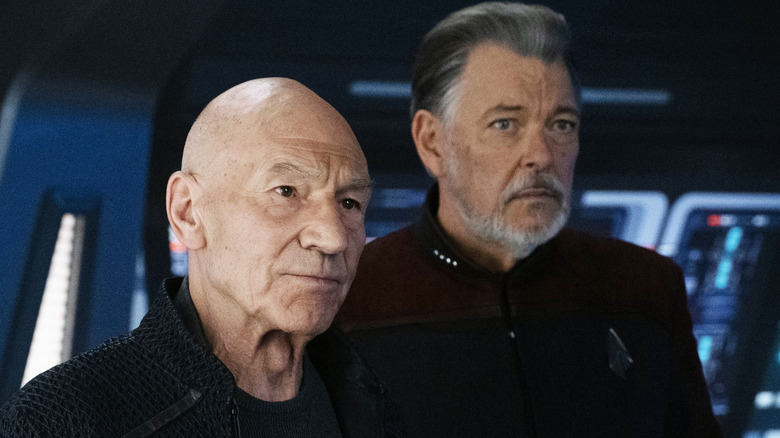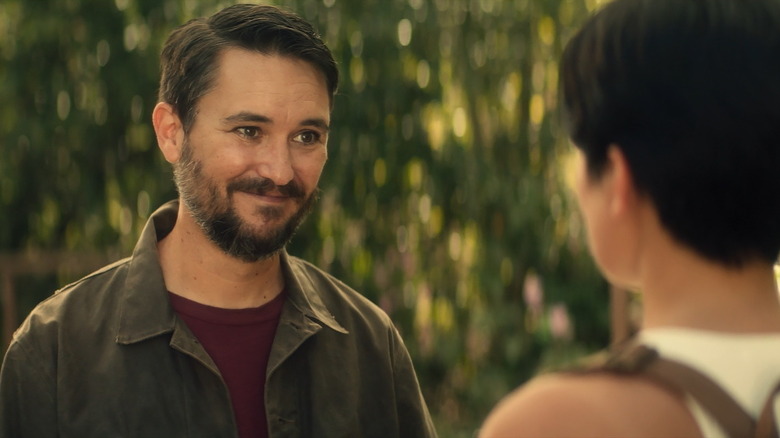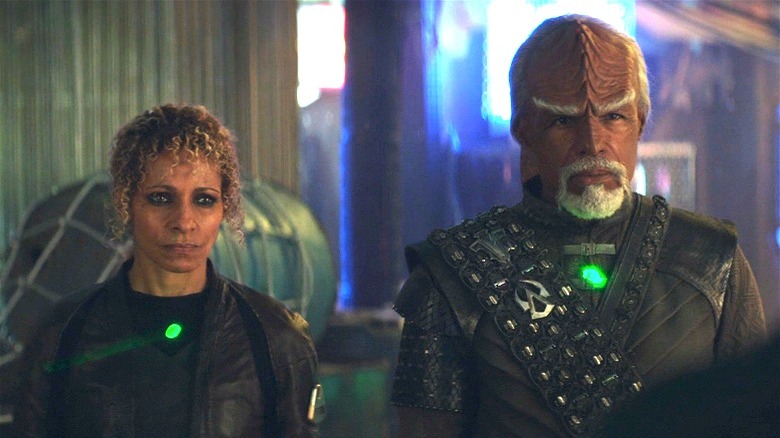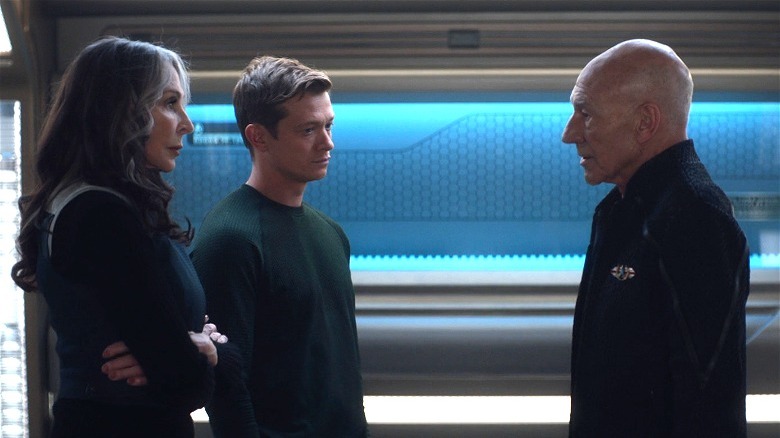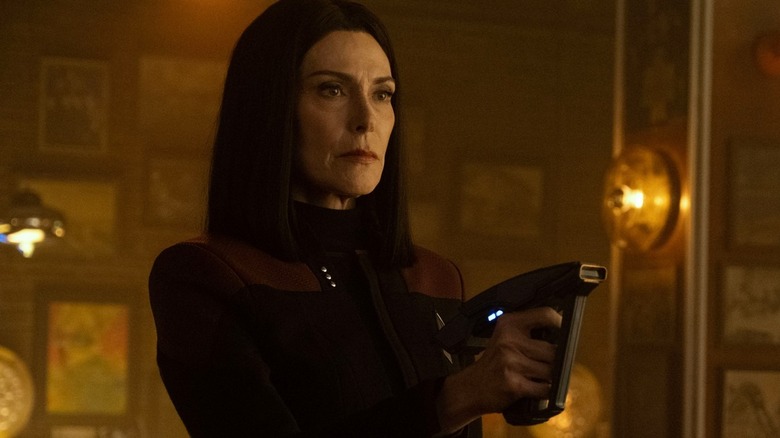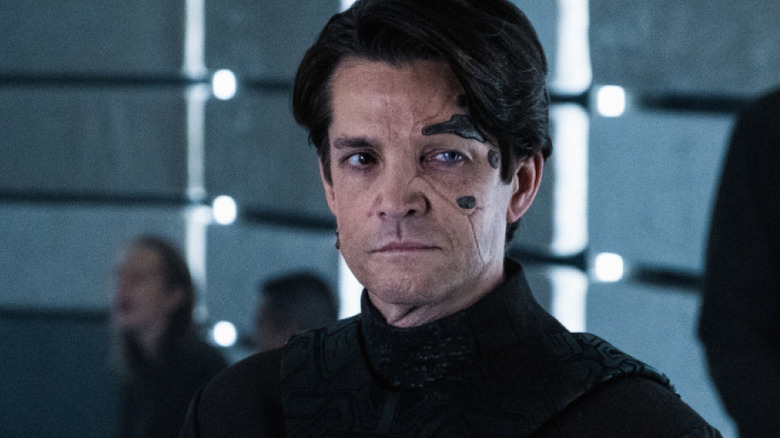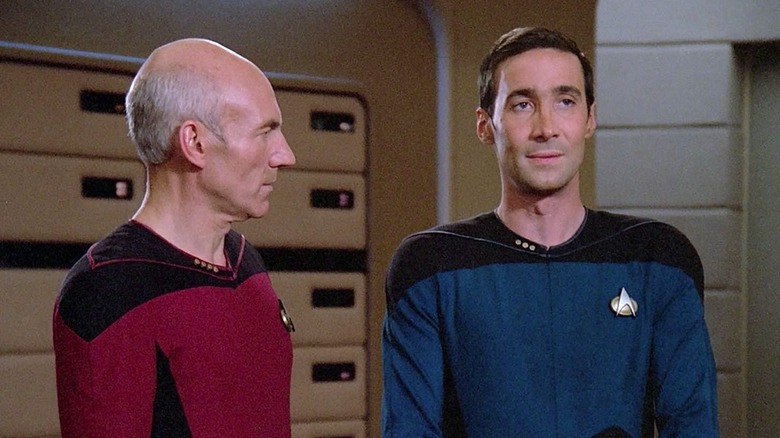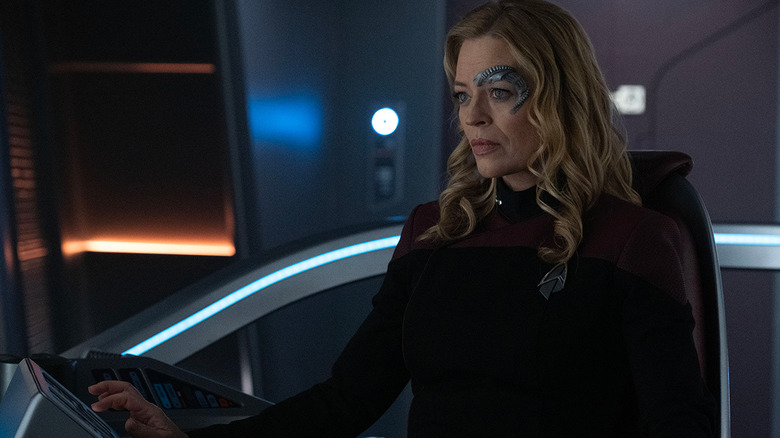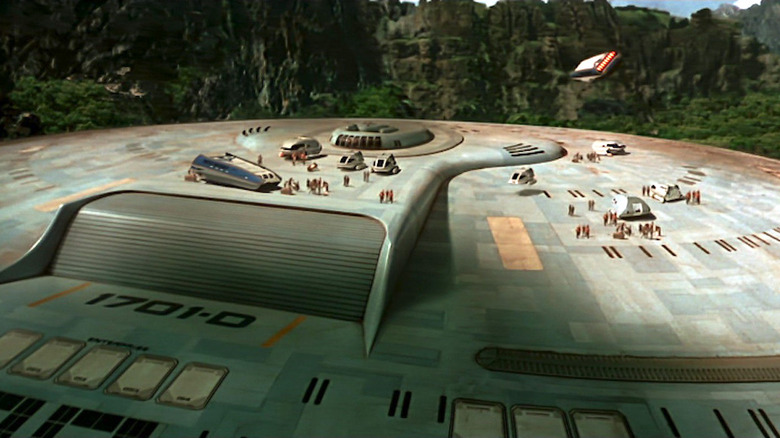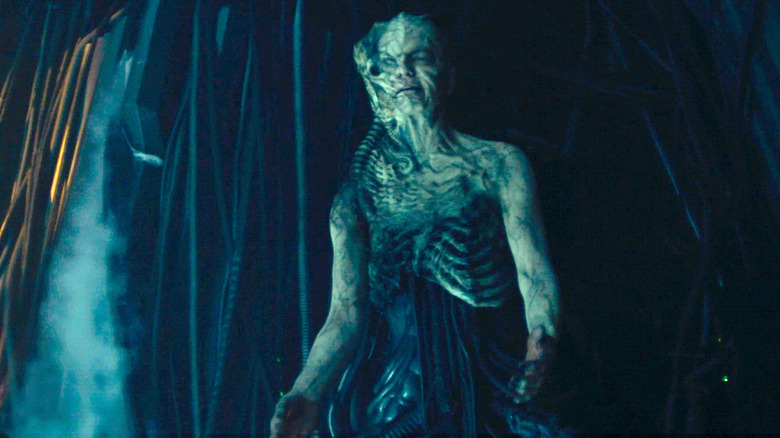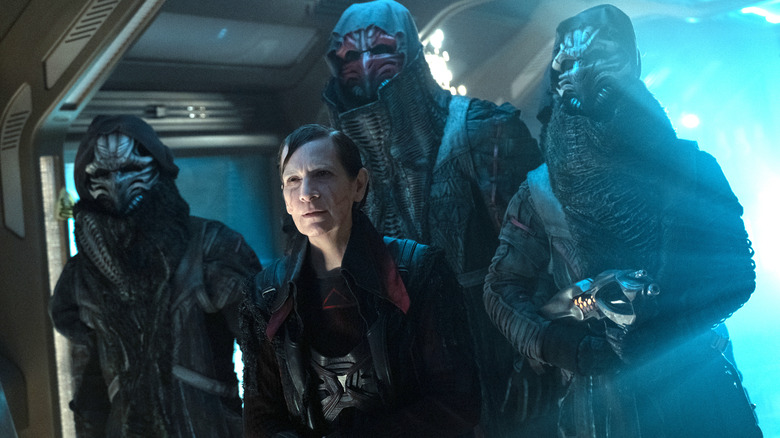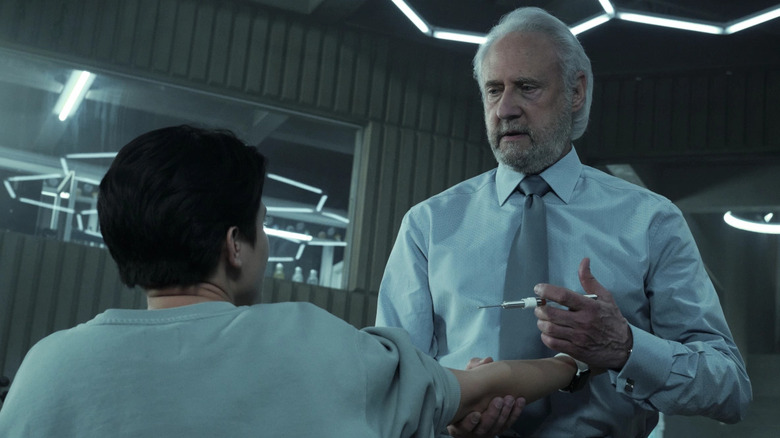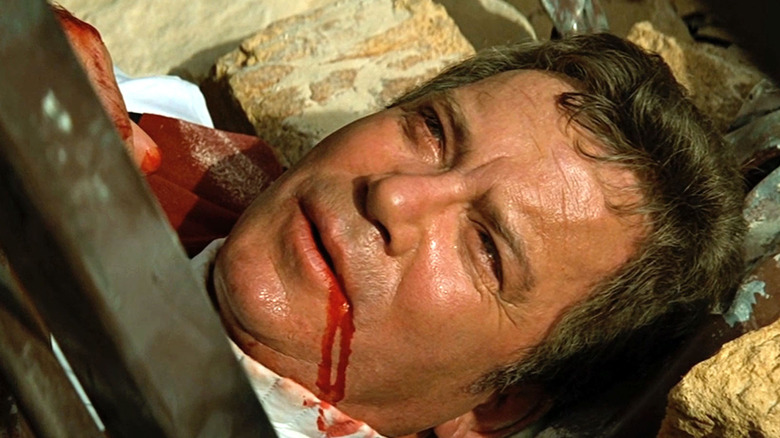The Biggest Star Trek Questions Answered By Picard
"Star Trek: Picard" saw fan favorite Patrick Stewart come back to the franchise, returning to the role of Jean-Luc Picard after more than 20 years. But fans expecting a reprise of "The Next Generation" were in for a rude awakening when the show debuted in 2020, as it featured a more downtrodden Picard assembling a rag-tag group of heroes for a personal mission outside the law. The second season saw John de Lancie reprise the character of Q, while the third and final season gifted fans with the "TNG" reunion they wanted, bringing back the entire cast of the 1987 series to give them a proper send-off.
During its three years, "Picard" did more than just tell new, thrilling stories centered on the beloved Enterprise captain. It also resolved a number of plot threads that were left dangling at the end of "The Next Generation," and with former Borg drone Seven of Nine added to the cast, it also addressed a few questions fans had after the conclusion of "Star Trek: Voyager." With a broad range of stories that tied back to old episodes from just about every incarnation in the franchise, "Picard" has managed to tie up plenty of loose ends. So secure all shuttle bays and prepare for warp speed, because we're exploring the biggest "Star Trek" questions answered by "Picard." Spoilers ahead.
Wesley Crusher tied up three loose ends
The Season 2 finale of "Picard" answered a trio of long-standing "Star Trek" mysteries. But first, a history lesson: In a classic "Star Trek" episode from 1968 we met interstellar agent Gary Seven, who's involved in 20th century affairs. Decades later, in "The Next Generation," we met another mysterious alien known as the Traveler, a being with psychic abilities who informs Captain Picard that Wesley Crusher is a special child with a unique destiny.
In the "TNG" episode "Journey's End," the Traveler returns to help Wesley uncover latent psychic powers of his own, and the two depart together for parts unknown. Unfortunately, despite a brief cameo in "Star Trek: Nemesis," we never learned anything more about Wesley's destiny, what his abilities meant, or what happened during his time with the Traveler. Little did we know that it was all connected to Gary Seven.
In the "Picard" Season 2 finale, all three questions are answered when Wesley returns, this time in the year 2024. He says he is now a traveler of space and time, and that he and his colleagues are responsible for dispatching "Supervisors" — like Gary Seven — to ensure the proper flow of time. He has arrived at this point in the past to recruit a new Supervisor, and his selection is none other than Kore, the genetically engineered daughter of Adam Soong (the ancestor of Wesley's old friend Commander Data).
We happened to mobile holo-technology?
For the first few seasons of "Star Trek: Voyager," the holographic Doctor was confined to sickbay and the holodeck. But in the two-part episode "Future's End," Captain Janeway and the crew have a time-traveling adventure that ends with them acquiring a piece of technology from hundreds of years in the future. This small, autonomous holographic emitter finally allows the ship's Doctor to move about unfettered through the ship, and even off of it, sometimes going on away missions.
While using a piece of futuristic technology violated all kinds of Starfleet protocols, it was simply too useful not to use. But the question remained: What would become of it after Voyager got back to Earth? Would the technology be confiscated for study, locked away to avoid polluting the timeline, or worse, would it be destroyed, forcing the Doctor back into a holodeck?
In "Star Trek: Picard," we learn what became of the technology, with Season 3 showing Worf and Raffi using one to deceive a group of underworld thugs. Though it's not said how widespread the use of the technology is, the fact that it's used at all says that at least Starfleet Intelligence counts it as a valuable tool. It also likely means that nobody from the 29th century — the time period it originates from — has come looking for it, perhaps suggesting that the mobile emitter's existence in the 24th and 25th centuries was not a problem for the timeline.
Did Picard and Dr. Crusher ever get together?
During "The Next Generation," Captain Picard and Dr. Crusher danced around their romantic feelings for one another, but at the end of the Season 7 episode "Attached" it was hinted that they might finally pursue a relationship. Unfortunately, despite the series finale "All Good Things" showing a possible future where the pair had been married (and divorced), the four films to feature the "TNG" crew never followed up on their romance.
Doubling down, the first two seasons of "Star Trek: Picard" continued to leave the status of Picard's relationship with Crusher a mystery, and even teased a romance with a new woman. But when Season 3 debuted in 2023, we finally got concrete answers. In the season's second episode, "Disengage," we learn that Picard and Crusher did indeed become lovers not long after the events of "Star Trek: Nemesis," but things didn't quite work out. And the reason why is that the good Doctor became pregnant: She feared for the life of her son, who she worried would become an ancillary target for his father's greatest enemies.
That son, Jack Crusher, became prey for Changeling agents, and he is later revealed to be crucial to their plot to destroy the Federation. During the third season, Picard, Crusher, and Jack reunite after saving the quadrant on Frontier Day, and they endeavor to become a family.
Did Ro stay with the Maquis?
Ro Laren was introduced as a disgruntled Starfleet officer in "The Next Generation." She became a protégé to Captain Picard in the episode named for her, "Ensign Ro." Joining the series as a recurring regular, Ro helped shake up the status quo. There were even plans for her to lead the spin-off series "Deep Space Nine," but actor Michelle Forbes declined and left the franchise, returning only for a single episode at the tail end of the show's seventh season.
In that installment, Ro was sent on a mission to infiltrate a terrorist group called the Maquis, but she wound up joining them instead. The episode left her fate unknown, and it's later said that the Maquis were all wiped out in a Dominion offensive. Had Ro Laren met her end? Well, in the "Picard" Season 3 episode "Imposters" we finally find out what happened to her.
According to Ro, she surrendered to Starfleet at some point after joining the Maquis and did time in prison. Eventually, she was recruited into Starfleet Intelligence, becoming one of their top operatives. In the episode, she comes aboard the U.S.S. Titan to get Picard's help in exposing a Changeling conspiracy, only to find herself the target of assassins. At the conclusion, Ro sacrifices herself, colliding with an enemy ship to allow Picard and the Titan the chance to escape.
A new hope for Hugh and the Borg
First introduced in the "TNG" episode "I, Borg," Hugh is a wayward Borg drone who gets nursed back to health by Picard and his crew. They briefly consider using Hugh as a living weapon against their greatest foe, but they reconsider after Hugh begins to exhibit his own personality and instead return him to the Borg collective. He turns up again in the Season 7 episode "Descent, Part 2," where we learn that Hugh's sense of self corrupted the Borg consciousness. The episode ends with Hugh stepping up to become the leader of a new rogue faction of Borg rebels, but the franchise left that plot thread hanging.
In the first season of "Picard," audiences were given a surprise when Hugh returned. Decades after we last saw him, Hugh serves as the Executive Director for an initiative called the Borg Reclamation Project, run out of an abandoned Borg cube, and whose goal is to de-assimilate drones to help them regain their individuality. As a former Borg drone (or xB) himself, Hugh also fights for the rights of his brethren and advocates for them to be re-accepted into their societies.
When the android Soji becomes involved with the project, Picard comes looking for her at the Borg Reclamation Site, leading to a tearful reunion between Picard and Hugh. Sadly, Hugh is killed while trying to help Picard escape during an attack from Romulan villains Narissa and Narek.
Did Maddox ever succeed at building an android?
All the way back in Season 2 of "The Next Generation," a now-iconic installment titled "The Measure of a Man" introduced a Starfleet scientist named Bruce Maddox, who was attempting to create more androids just like Commander Data. Initially an antagonist who attempts to force Data to undergo a dangerous procedure to learn about his inner workings, Maddox eventually comes to accept that Data is an individual with the right to his own bodily autonomy. Unfortunately, the only update audiences would ever get on Maddox's work came in the Season 4 episode "Data's Day," where Data addresses a letter to him to help in his work.
Flash forward to the first season of "Picard," where some answers regarding the fate of Maddox were finally given: Audiences were in for a shock when they discovered that he was at the center of the story. According to Daystrom Institute researcher Dr. Agnes Jurati, Maddox eventually succeeded in using Data's twin B-4 to help him construct a new wave of artificial life forms. Alongside Altan Soong, the son of Data's creator, Maddox established a research station on the remote planet of Coppelius and built an entire artificial race of androids.
After a deadly attack by Synths, however, the Federation banned the creation of artificial life, and Maddox became convinced that it was part of an elaborate conspiracy. In his attempts to expose the perpetrator, Maddox became a target, ultimately being killed by his own assistant under the coercion of a Romulan agent.
Seven's future in the Alpha Quadrant
Following the introduction of Seven of Nine in "Star Trek: Voyager," the ex-Borg drone struggled to accept her re-emerging humanity. Over the course of her four seasons on the show, Seven often expressed a reluctance to return to the Alpha Quadrant with the rest of the crew, unsure of how she would be treated as a former Borg, and uncertain if she'd ever belong. Unfortunately, due to the rushed series finale "Endgame," audiences never learned if Seven ever found a place to belong in the Alpha Quadrant. It would take more than two decades before fans found out what happened to her, and their first glimpse of her in "Picard" probably wasn't what most Trekkies had imagined.
When we first come across her in "Picard," Seven is a rogue agent working with the Fenris Rangers, a group of peace-keeping outlaws on the fringes of Federation space. It seems that when she first returned to the Alpha Quadrant, she'd been denied entry into Starfleet based on her Borg physiology. After adventuring with Admiral Picard, Seven eventually re-applied to Starfleet, and with the help of both Picard and Admiral Janeway, she secured not only entry into the service, but was granted a commission as first officer of the U.S.S. Titan under the command of Captain Liam Shaw.
In the emotional conclusion to "Star Trek: Picard," following Shaw's death, Seven is promoted to captain and given command of the Federation flagship, the U.S.S. Enterprise-G.
What became of all those Enterprises?
Over the years, the final fate of the various Enterprises has been left up in the air, bar the odd destruction seen on screen. But in Season 3 of "Star Trek: Picard," we learn what's happened to four of the starships named Enterprise. Most of that is thanks to the inclusion of the Fleet Museum, which is under the command of Commodore Geordi La Forge.
While we already knew from dialogue in "Star Trek: Enterprise" that the original NX-01 Enterprise sat in the museum, we see it here for the first time. "Picard" reveals that the ship received a refit, which added a secondary hull. But beyond Captain Archer's NX-01, we also get a glimpse of Kirk's Enterprise-A, which is on proud display at the museum. It must have been sent there after being decommissioned following the events of "Star Trek VI: The Undiscovered Country."
That's not all, though. In addition to learning that the Enterprise-E was confirmed to be (or at least very likely to be) destroyed while Worf was in command, we also see the return of the Enterprise-D. After crashing on Veridian III in "Star Trek Generations," it seems the surviving saucer was salvaged and given the star drive section of another, similar ship. It was then restored by Geordi La Forge, who resurrected it for one final mission to take down the Borg in the series finale of "Star Trek: Picard."
Did the Borg survive Captain Janeway?
Since their introduction, the Borg have remained the most terrifying adversary on "Star Trek." Once Captain Picard got done with them on "TNG," they re-appeared in the 1996 film "Star Trek: First Contact," and they later showed up in "Star Trek: Voyager," serving as the villains in the two-hour finale. In that story, a time-traveling Admiral Janeway arrives from the future with a plan to get the ship back to the Alpha Quadrant years earlier than it would have otherwise, but doing so will force them into a showdown with the Borg Queen.
At the close of the episode, future Janeway infects the Borg with a deadly virus that wreaks untold havoc on the Queen and her army of drones. Untold is the right word, too, because audiences were never informed about what happened next. Were they damaged just enough so that they couldn't stop the Voyager from returning home, or were they wiped out completely? The epic third season of "Star Trek: Picard" finally answered that question.
As it turns out, the Borg were decimated by Janeway's virus, though the Queen herself managed to survive by using the life force of the few remaining Borg to sustain her. Decades of loneliness gave way to hope, however, when she learned of Jack Crusher, the son of Picard who inherited some of his father's Borg-altered DNA. In the end, her plan to rebuild the Borg failed, and she was defeated once more by Picard and the Enterprise crew.
The fallout from the Dominion War
Arguably the biggest open question left at the conclusion of "Star Trek: Deep Space Nine" was what became of the vaunted Dominion. A vast empire ruled by shapeshifting Changelings in a distant part of the galaxy, their emergence into the Alpha Quadrant led to a sprawling interstellar war that saw just about every major "Star Trek" power fighting for survival. But when the dust settled, and the Dominion were defeated, many fans were left to wonder what actually became of them. Though "Star Trek: Picard" didn't provide all the answers, the creators did at least give an update on the Founders of the Dominion.
"Picard" Season 3 introduces the Changeling villain Vadic, a prisoner of war held by Starfleet and used in gruesome experiments aimed at creating living weapons. When Vadic escapes her imprisonment at the hands of the clandestine Starfleet intelligence agency Section 31, she leads a splinter group of shapeshifters on a vengeful quest to destroy the Federation, forging a bold alliance with the surviving Borg Queen. While Vadic is defeated by the end of the season, the fate of the Dominion itself in the Gamma Quadrant is still left to be pondered.
Khan gets an origin
Played by Brent Spiner in "Picard," Adam Soong is the apparent first in a lengthy line of geniuses that would ultimately lead to the creation of the android Data, who Spiner played on "The Next Generation." It seems that in the year 2024, Soong was a visionary scientist experimenting with genetic engineering, at first appearing to be developing treatments to cure his daughter Kore of a debilitating disease. It's later revealed, however, that Soong is a eugenicist, and he has been attempting to create the ideal human specimen using artificial means.
Over many decades, Soong cooked up numerous artificially-created people in the form of a series of "daughters," almost all of whom died before the age of four. With each new experiment, Soong perfected his methods and became certain he could eventually accomplish his ultimate goal. After his daughter Kore abandons him and much of his work is destroyed, a final stinger reveals one secret, apparently incomplete project that Soong has been working on called Project Khan.
The implication is clear: Adam Soong is at least partly responsible for the creation of the villain Khan Noonien Singh, the diabolical tyrant who fought the Eugenics Wars in "Star Trek" lore. Paired with new information gleaned from the pilot episode of "Strange New Worlds," it would seem that Khan's creation played a role in what began as the Second Civil War, became the Eugenics Wars, and ended in World War III.
A final resting place for Captain Kirk
If the "TNG" movies made any mistakes, it was the death of Captain James T. Kirk in "Star Trek Generations." A controversial move at the time to kill off one of the franchise's most beloved characters, even the actor himself, William Shatner, never wanted Kirk to die. The last we saw on-screen, Kirk's body was left buried under a pile of rocks on Veridian III, a pretty undignified end for such a legend, and fans have often wondered if that was really his final resting place.
Not long after "Generations," of course, Shatner himself co-wrote a novel that resurrected the character, in a story that saw his body exhumed and used to bring Kirk back to life. Decades later, something strikingly similar was shown in "Star Trek: Picard."
In the episode "The Bounty," Riker, Worf, and Raffi sneak aboard the Section 31 facility Daystrom Station, where the organization keeps its most top secret assets. While walking its corridors, fans were treated to a veritable goldmine of Easter eggs, and one of them was the body of James T. Kirk. Eagle-eyed fans were even able to decipher a wall-panel graphic that claimed Kirk's body had been recovered from Veridian III with the goal of using it as part of something called "Project Phoenix," suggesting that Section 31 may indeed be trying to resurrect the legendary hero.
